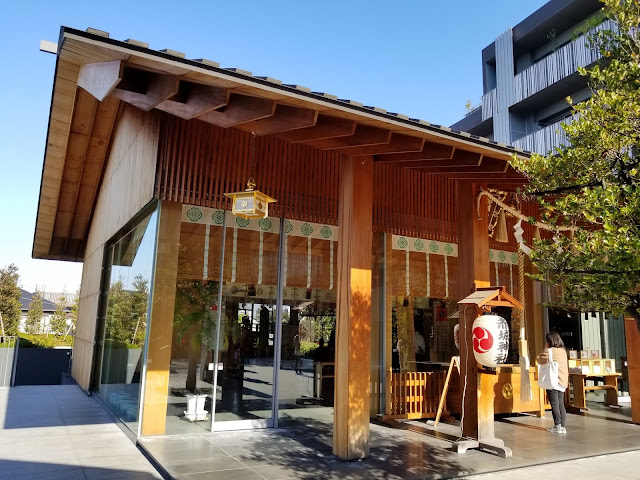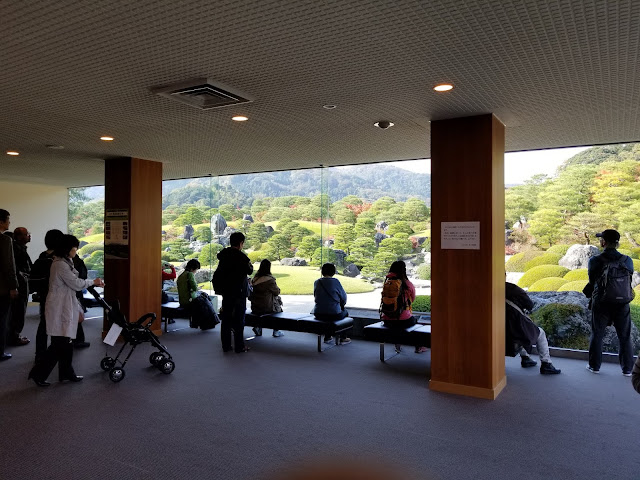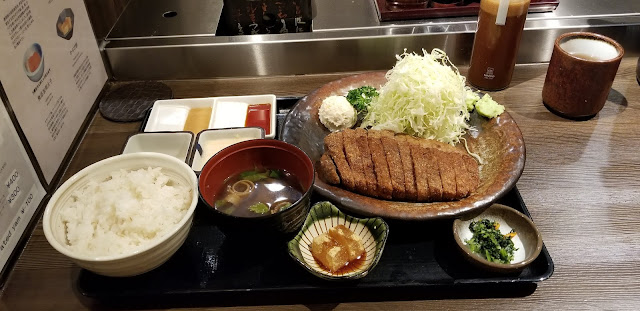
If you go to Japan, you will inevitably visit temples and shrines. Temples are associated with Buddhism and shrines, called jinja (神社, じんじゃ) in Japanese, with the native Shinto religion. Customs and practices are different between the two, and these places of worship can be found in all parts of Japan from the largest cities to the smallest village. There are an estimated 80,000+ Shinto shrines in Japan [1] and the common picture that comes to mind is that of a traditional well preserved building that has graced the area for a long time. That picture is true for most shrines in Japan, but not for the Akagi Jinja (赤城神社). The Akagi Jinja has been in the Kagurazaka neighborhood in Tokyo since the 1500's [2], but the traditional buildings on the shrine grounds were replaced with a modern architectural interpretation in 2010 by noted Japanese architect Kuma Kengo. He also designed the condominiums adjacent to the shrine, which has a café open to the public on the first floor. Having condominiums with a café on shrine grounds is highly unusual in Japan. This modern interpretation of a Japanese shrine is unique and worth a visit when you're in Tokyo. The shrine is an easy two minute walk from Kagurazaka Station on the Tokyo Metro Tozai Line.
Thursday, May 16, 2019
Not Your Typical Japanese Shrine: Akagi Jinja (赤城神社), Kagurazaka, Tokyo, Japan
Sunday, March 31, 2019
Kumamoto Castle (熊本城, Kumamoto-jō), Kumamoto, Japan
Kumamoto Castle is located in Kumamoto City on the southernmost Japanese main island of Kyushu, about six hours and a distance of approximately 1300 km (800 miles) from Tokyo, or about 3.5 hours from Osaka (Shin-Osaka Station) by Shinkansen. Kumamoto Castle is one of the three most famous castles that travelers should see when visiting Japan (the other two castles being Himeji and Matsumoto Castles) [1]. A large-scale renovation of the inner castle was completed in Dec 2007, in time for the castle's 400th anniversary [2]. I was fortunate enough to visit the castle in Dec 2009 (and Matsumoto Castle; Himeji Castle had been visited previously) to see the results of the renovation before my most recent visit in Nov 2017.
On 14 April 2016, a magnitude 6.2 earthquake struck the island of Kyushu, which caused major damage to many places on the island, with Kumamoto Castle having the most visible and significant. Roof tiles fell, foundations were damaged, entire structures collapsed, and the stone walls sustained major damage. Sections of the wall collapsed (as pictured above), leaving some structures perilously close collapsing themselves. The repairs to the castle started two months after the earthquake and has a target completion date of 2036 (yes, an estimated 20 years to repair the damage!) [2]. Whereas previously you could freely walk the grounds of the castle before the earthquake, visitors are now restricted to walking the perimeter of the castle while reconstruction is in progress (for obvious safety reasons). The route is well marked, easily walkable, and there are numerous informative signposts in Japanese, English, Korean, and Chinese (Simplified and Traditional) along the way.
Thursday, January 31, 2019
Adachi Museum of Art (足立美術館), Yasugi, Japan
This article was updated on 18 Sep 2021 to clarify the details on taking the train to Yasugi Station and the Adachi Art Museum.
The Adachi Museum of Art (足立美術館, Adachi Bijutsukan) should be on everyone's sightseeing list when visiting Japan. While it is an art museum, the real reason you should visit the museum is to see the 16.5 hectare (40.7 acre) garden. The garden has been voted the number one Japanese garden since 2003 by the Journal of Japanese Gardening. The museum's founder, local businessman Zenkō Adachi (1899-1990), believed "the garden is also a picture" and devoted himself to gardening until his death. As seen in the picture above, the inside of the museum was designed to frame the garden as a picture. While the views from inside the museum impressive, the views of the garden from outside of the building are spectacular (visitors are not allowed into the garden themselves). The views change with the four seasons, so one visit will only give you a glimpse of garden's possibilities. I've been fortunate to visit the garden twice, once in Dec 2009, and more recently on 14 Nov 2017. Please continue reading the rest of the article and to see more photographs.
Tuesday, January 8, 2019
Station Master Tama: The Cat That Saved A Railroad, Wakayama, Japan
Wakayama Electric Railway (和歌山電鐵, Wakayama Dentetsu) is a private railway line that operates just one 14.3 km (8.9 mile) train line, the Kishigawa Line (貴志川線, Kishigawa-sen), between Wakayama and Kishi stations [1]. In Japan, small and short railway lines are not profitable due to the dwindling population outside the cities, and many of these lines have closed. However, this small line is open and operates profitably today because of a cat. I took the Tamadensha train (aka "Cat Train") for a visit on 23 Oct 2018.
Please read the rest of the article to find out more about this unique railway and its now famous cat station master, and to see more photographs.
Sunday, December 30, 2018
Kumano Nachi Taisha (熊野那智大社), Wakayama Prefecture, Japan
This will probably be the last posting for 2018. I wish you and your family a Happy New Year for 2019. The last post this year is for a unique Japanese shrine using the travel blog, rather than my previous end of the year posts in the food blog. I hope you have enjoyed both blogs, and if you have not already, please "Follow" and give the blogs a "Like" on Facebook (food: https://www.facebook.com/ducksoupeasy/, and travel: https://www.facebook.com/ducksoupeasytravel/). Thanks, and I will see you next year.
Kumano Nachi Taisha (熊野那智大社) is a Shinto shrine and part of the UNESCO-designated World Heritage Sacred Sites and Pilgrimage Routes in the Kii Mountain Range of Japan. [1] The shrine is one of three sacred shrines, known as the Kumano Sanzan (熊野三山) or the Three Grand Shrines of Kumano, located on the Kii peninsula in Wakayama Prefecture, south-east of Osaka. The other two sacred shrines are Kumano Hongu Taisha and Kumano Hayatama Taisha. The shrines are located on a sacred pilgrimage route known as the Kumano Kodō (熊野古道). While it is still possible to walk the original ancient Kumano Kodō, the sites are now accessible by more modern trains and buses. The most notable sight at the shrine is the three-storied pagoda located near the highest single-drop waterfall in Japan. I visited the shrine on 22 Oct 2018.
Thursday, November 15, 2018
Gyukatsu Motomura Nishi-Shinjuku (牛かつ もと村 新宿店) Restaurant, Tokyo, Japan
I visited the Gyukatsu Motomura Nishi-Shinjuku (牛かつ もと村 新宿店) Restaurant in Tokyo, Japan on 2 Nov 2018. The specialty of the restaurant is beef tonkatsu, which is deep fried beef, rather than the usual pork tonkatsu found in Japan.
Please continue reading the rest of the article to find out more about my dinner at Gyukatsu Motomura Nishi-Shinjuku and to see more photographs.
Tuesday, November 6, 2018
Toyosu Market (豊洲市場, Toyosu Shijō): Tsukiji Market's (築地市場, Tsukiji Shijō) Replacement, Tokyo, Japan
The Markets
This article was updated on 16 Aug 2022 to include a link to an article about my visit to the Tsukiji tuna auction on 17 Feb 2005.
Tokyo's Tsukiji Market (築地市場, Tsukiji Shijō) is famous the world over. Primarily known for its early morning (5:30-6:30 AM) tuna auction, it is also Tokyo's supplier of seafood, as well as fruits and vegetables. Tsukiji Market actually consisted of two markets: the Inner and Outer. The Outer market has many restaurants and open stall retail shops selling fresh fish, produce, and all sorts of wares. The Inner market was the wholesale area for fish (and the famous tuna auction), produce, restaurants, and shops.
Tsukiji Inner Market is now closed, and the tuna auction and wholesale areas have all moved to modern, enclosed, temperature-controlled buildings at Toyosu Market (豊洲市場, Toyosu Shijō). Please continue reading the rest of the article to find out more about my visit to Toyosu Market, soon after it opened, on 04 Nov 2018.

